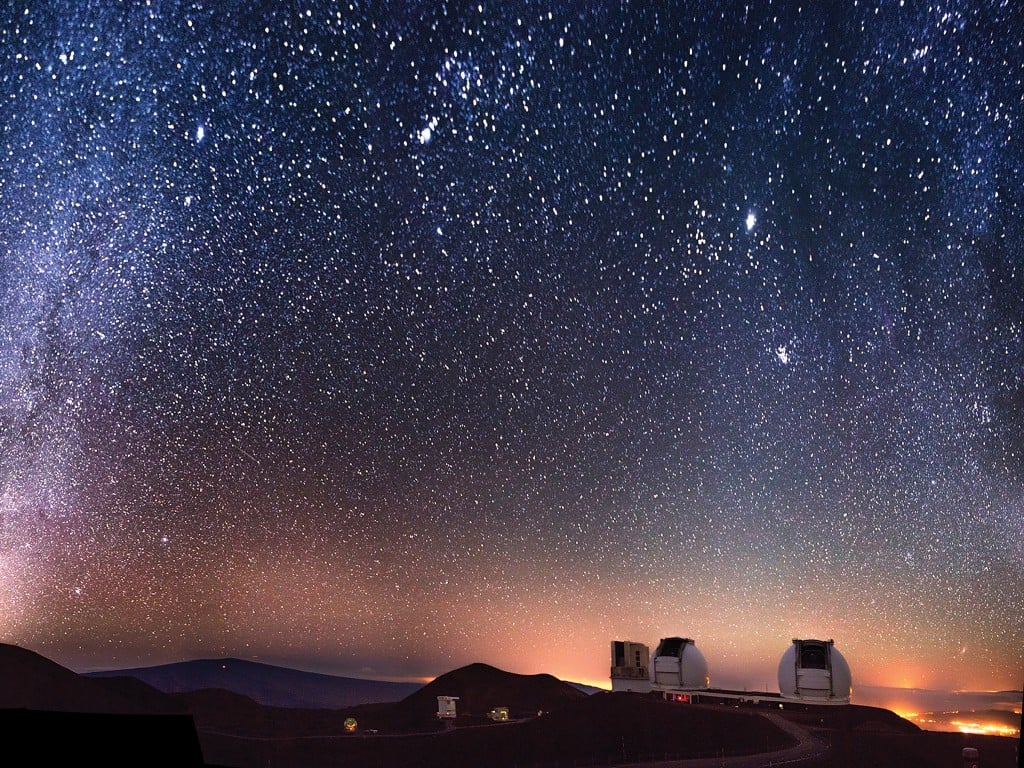What’s Astronomy’s Future in Hawaii

For weeks, the astronomers, technicians and support staff working on Mauna Kea watched the protesters.
Native Hawaiians and others opposed to the massive Thirty Meter Telescope gathered near the 9,000-foot mark, their encampment near Hale Pohaku, the small campus where observatory workers stay when they’re not at the summit. In March, the protesters blocked the summit road, stopping construction vehicles. Then, on April 2, observatory workers watched in shock as 12 were arrested.
Doug Simons, director of the Canada-France-Hawaii Telescope, and a 30-year veteran of Mauna Kea observatories, says the moment was a wake-up call for everyone on the mountain. “I realized things have fundamentally changed with Hawaii astronomy,” he says.
In 1968, Gov. John A. Burns led the way in establishing a science reserve at the summit of Mauna Kea, hoping Hawaii could capitalize on the mountain’s unique attributes to attract an astronomy industry and establish the state as a leader in the field. A half century later, his vision appears to be a stunning success: The summit is now home to 13 observatories, and Mauna Kea is widely recognized as the most productive astronomical research site in the world.
But astronomy in Hawaii is at a crossroads. Many in the research community admit they were caught flat-footed by the size and intensity of the protests last year. The Hawaii Supreme Court’s decision in December to void TMT’s conservation district use permit on procedural grounds stunned both protesters and astronomers, and rattled the astronomical community worldwide. And the renewal in 2033 of UH’s lease on the Mauna Kea science reserve, once assumed to be a sure thing, now seems uncertain.
What happens next – and in the decades to come – likely depends on the project that intensified the debate over Mauna Kea.
“We’re all concerned about the future of Hawaii astronomy, and right now I think everybody is looking for TMT to decide what they’re going to do,” Simons says. “I think you’ll see a pivot one way or another by all sides, pending TMT’s decision on how they’re going to respond.”
Caught Off Guard
Members of the scientific community did not expect smooth sailing for TMT. In recent history, both the Keck telescope on Mauna Kea and the Daniel K. Inouye Solar Telescope on Haleakala encountered criticism and opposition during the permitting process. But most were caught off guard when the fight against TMT quickly escalated on the mountain and spread across the state and around the world.
“This large wave of protest has really surprised us,” says Gunther Hasinger, director of UH’s Institute for Astronomy. Officials believed TMT and the university had taken extensive steps to mitigate impacts and address concerns, he says.
Simons says workers were deeply affected by the “intense,” ongoing presence of protesters near Hale Pohaku. Clashes with police in April brought a turn. “I witnessed the very rapid change in the mood of my staff after the arrests,” Simons says. As the controversy flared on social media, “everybody went quiet,” he says.
“My staff went from being genuinely quite proud of being associated with CFHT, to being concerned about being identified as working at an observatory. It was really disturbing to me to see that rapid mood change.”
The Hawaii Supreme Court’s decision to void TMT’s permits and send the project back to square one shocked the astronomical community worldwide, Simons adds. “TMT is very widely known – it’s a big, international project. I think the loss of the permit was kind of a bomb that went off from an international perspective on Hawaii astronomy.”
Scientists worldwide are watching Hawaii to see what happens next. “There is a worry that these developments will lead to less utilization of Mauna Kea for astronomy,” he says.
“If TMT decides to pull out – and I honestly don’t know what they’re going to do – that would really send a bad message,” Simons says. “Combined with the master lease and its uncertain future, it really puts Hawaii astronomy in a bad light from an international perspective.”
Some project funders are more measured. “It’s hard to read the minds of people in black robes, but you do know that, when there’s a court case, it can go either way,” says Robert Kirshner, chief program officer for science of the Gordon and Betty Moore Foundation, and a professor of astronomy on leave from Harvard University.
The Moore Foundation has provided around $180 million to TMT so far, starting in 2003, through grants to the University of California and California Institute of Technology.
While Kirshner notes the Moore Foundation doesn’t have a vote on the telescope’s international board of directors, he says many factors will likely go into the decision about how to move forward. Despite Hawaii’s political challenges, it’s still a very attractive site, and not just because of its unique astronomical attributes. “A big plus,” he says, is that several TMT partners, including Canada and Japan, already have telescopes on Mauna Kea and are comfortable working and collaborating there.
TMT executive director Ed Stone says it’s too soon to say where the project will go from here. “We’ve got no feedback from the state yet as to what needs to be done this time, nor how long it will take,” he says. “We have to wait until the state tells us what it would like us to do.”
But a key factor, he says, will be, “How certain we are that, having gone through this a second time, we will end up with a valid, enforceable permit.”
On Feb. 11, following a meeting of the TMT board of directors, board chairman Henry Yang confirmed Hawaii remains the observatory’s first choice, but that officials would also begin looking at other options. “Given the enormous investment and potential challenges ahead, it is necessary to also carry out a review of alternative sites,” he said. Opponents called the statement an effort to pressure the state.
At 30 meters in diameter, two large school buses could park end to end across the light-collecting surface of TMT, with room to spare. The project is part of a new wave of giant telescopes being built around the world, including the 39-meter European Extremely Large Telescope and the 25-meter Giant Magellan Telescope in Chile. Scientists say these mega-telescopes represent the next generation of astronomical research.
“A bigger telescope allows you to look farther into the past, and see the history of the universe by looking at distant galaxies,” Kirshner says. They are also capable of seeing “faint things next to bright things,” a critical capability in studying exoplanets orbiting far-away stars, one of the hottest research areas in astronomy today.
Losing TMT will do more than affect the perception of Hawaii in the astronomical community, researchers say. Without a giant telescope of its own, Stone says, Mauna Kea “won’t be keeping up.”
“Right now, Mauna Kea has two of the largest telescopes on earth, so it’s a world-leading observatory,” he says. “But, 10 to 15 years from now, (without TMT) it will no longer have the forefront instruments.”
Lease Countdown
Adding to the uncertainty around Mauna Kea’s astronomical future is the question of the university’s lease on the summit science reserve, which is set to expire in 2033. “Twenty years ago, most people would have assumed that the master lease would be renewed,” Simons says. “Now I think things have changed a lot.”
The Office of Mauna Kea Management had already begun holding public planning meetings on the renewal early last year. But that process got put on hold after the TMT controversy and Gov. David Ige’s release of a 10-point plan for Mauna Kea, says UH spokesman
Dan Meisenzahl.
While Ige called for UH to “substantially reduce the length of its request,” Hasinger notes the governor did include the renewal as part of his plan. “He made it clear he is still envisioning an extension of the lease, although maybe not to the maximum length,” he says.
It seems certain that many of the same groups that protested TMT will be active in opposing any extension of the university’s presence on Mauna Kea.
“We’ve got no feedback from the state yet as to what needs to be done this time, nor how long it will take. We have to wait until the state tells us what it would like us to do.”
— Ed Stone, Executive director, Thirty Meter Telescope
Kealoha Pisciotta, a leader with Mauna Kea Hui, one of the plaintiffs in the case that led to the Supreme Court’s ruling against TMT, says her group would continue to fight for its goals, which include stopping any new construction on Mauna Kea, requiring observatories to pay fair-market rent for their land and establishing a management authority independent of the university.
“We are poised and prepared to litigate on any of these things – particularly now, since we’ve won – and there is no justification for another 65 years (on the lease),”
she says.
Pisciotta said the university’s history of mismanagement of the summit area – with violations documented in state audit reports in the 1990s – and a trail of broken promises that include building more observatories than originally planned, should disqualify it from continuing to occupy Mauna Kea. Without TMT, there would be no reason to extend the lease, since existing telescopes were aware of its expiration date when they were built, she says.
“They already signed the agreement for 65 years,” Pisciotta says. “They know the limit.”
The issue of the renewal may be more significant to Simons than some other observatory directors. That’s because CFHT is currently the only Mauna Kea facility contemplating a major upgrade in the near future. The Maunakea Spectroscopic Explorer would replace the facility’s existing 3.6-meter optical telescope with a new 11-meter telescope. The new observatory would be capable of conducting powerful sky surveys, analyzing the light signatures of millions of stars and galaxies each year. “It would be completely unique worldwide,” Simons says.
Knowing the difficulties of building on the mountain, CFHT constrained the project up front, ruling out a plan to tear down the existing facility and pour a larger footprint. Instead, they would install the new telescope on their existing pier, and replace their current dome with a slightly larger one. “It’s about the most benign way you could think of to have such a huge change in capability,” he says.
But the new telescope probably wouldn’t see first light before 2025, making the lease’s 2033 expiration date uncomfortably close for Simons. “A quarter-billion-dollar-type project like the one we’re thinking about – I have very strong concerns about raising funding for that without the master lease being renewed,” he says.
While CFHT is the only observatory with immediate plans for an upgrade, the other facilities will ultimately face the same issue, Hasinger says. He notes that some observatories on the mountain are now almost 40 years old.
“If we don’t do something to renovate them, the deferred maintenance will lead to them not working anymore,” he says.
Heading South?
It’s not just Mauna Kea’s altitude that makes it valuable for astronomy. The mountain’s smooth slope and the surrounding ocean means the air above is unusually free from turbulence, producing exceptionally clear viewing conditions. And the presence of so many other top-tier telescopes nearby makes it fertile ground for world-class collaborations, scientists say.
The only other site in the world capable of competing with Mauna Kea scientifically is the high mountains of Chile, researchers say. While Mauna Kea might have an edge in slightly better viewing conditions, the two sites are “not even close” politically, says Simons.
Simons, who previously headed the Gemini Observatory, which has a sister site in Chile, has worked in both locations. “The president of Chile, the Cabinet – there’s a reason there is a lot of astronomy in Chile, and they’re extremely welcoming to these types of facilities,” he says.
“I’ve seen both sides in detail and, compared to Chile, what’s occurring in Hawaii is a radically different reaction to astronomy,” Simons says. Those factors won’t be overlooked by the large funding agencies like the National Science Foundation when they’re deciding where to invest in large astronomical projects, he says.
While Hawaii’s political challenges seem unlikely to end anytime soon, the astronomy community and its supporters say they’re hoping to build a stronger base of support by changing their approach to community outreach.
Since the controversy, observatory leaders and workers became more proactive about speaking to media, and organized community meetings to discuss the mountain and protesters’ concerns. They also organized to launch the Kamaaina Observatory Experience in January (see sidebar on page 61).
“We decided to start to try to tell our stories,” Simons says. “In time, it has turned around to where we have a number of perspectives out there as opposed to early on, where it was a classic deer-in-the-headlights situation.”
Community supporters of the telescopes also mobilized. “What it really told us is we need to do a better job of communicating the value of what astronomy and education bring to our people,” says Big Island farmer and businessman Richard Ha, who has helped organize public meetings and outreach on behalf of TMT and the observatories. “We were far behind, in my opinion.”
“It’s not all benevolent science. It’s big money. If it wasn’t then why would they all want to do it?”
— Kealoha Pisciotta, A leader with Mauna Kea Hui
Pisciotta is skeptical of the observatories’ new enthusiasm for outreach and engagement, saying the effort is too little, too late. “They’re all saying, ‘We need to build our reputation,’” she says. “But it’s like, you should have done that years ago. You lost the trust of the people of Hawaii years ago.”
And while the astronomy community contends the observatories are nonprofit organizations with a mission to advance human knowledge, Pisciotta doesn’t buy it. “It’s not all benevolent science,” she says. “It’s big money. If it wasn’t then why would they all want to do it? Truthfully, it won’t make a difference to the world so much that there’s a brown dwarf out there, or a black hole. But where there’s money to be made is at the secondary level – patenting the technology that’s developed and sold.”
One organization that hopes to bridge the divide is Imiloa Astronomy Center in Hilo. It has long focused on educational programs and exhibits that present both Native Hawaiian and Western approaches to astronomy. Now, executive director Kaiu Kimura envisions more active community engagement.
“We are recharting our course,” she says. “We recognize our critical role in the community to bring about dialogue.”
The center is partnering with observatories on the Kamaaina Observatory Experience, and will be adding new exhibits that explore different perspectives on Mauna Kea, hosting panel discussions, and starting a new monthly lecture series that will feature experts, cultural practitioners and others who have a relationship with the mountain – including protesters, Kimura says.
She says the fight over astronomy has been hard on Big Islanders. While groups on either side are deeply divided and passionately aligned behind their causes, many others are left out of the discussion.
“Those in the middle are over-whelmed with the conversation,” she says. “I think there’s a great sense of frustration over the controversy on Mauna Kea, and a great desire to see resolution and forward movement.”
House of the Sun
While protests have mainly focused on Mauna Kea, astronomers on Maui have also been feeling the heat.
Last summer, protesters blocked a transport of building materials to the Daniel K. Inouye Solar Telescope on Haleakala. Although the situation didn’t delay construction, project manager Joseph McMullin says it caught observatory leadership off guard. “Because we had already been engaged with the Native Hawaiian community, we were surprised at that level,” he says.
DKIST leaders met with cultural leaders to discuss the situation, how to address concerns and how to ensure public safety during transports, he says.
When it comes online in 2019, DKIST will be the largest and most powerful solar observatory in the world. DKIST director Thomas Rimmele notes that much of the science done there will have a direct impact on life on Earth. The telescope will study phenomena like the 11-year solar magnetic cycle, which affects global climate change, as well as study solar flares and coronal mass ejections, which can fry technology and knock out electrical grids.
“It’s really a long list of impacts, and we’re trying to understand the source of these impacts,” Rimmele says. “Our ultimate goal is to understand the physical mechanism of the sun well enough to predict these events.”
All observations gathered by DKIST will be released to the world as open-source data, he notes.
The external shell of the observatory is nearly complete, and the internal structure is on track to be finished by June, McMullin says. Then the team will begin installing the telescope’s scientific components and instruments.
“Inside the building there’s so much more to go,” he says.
UH Institute for Astronomy director Gunther Hasinger acknowledges the protests that started on Mauna Kea “leaped over to Haleakala” last year. But he notes several factors make the political situation on the two mountains different.
While the university is responsible for the entire summit area on Mauna Kea, on Haleakala that area is managed by the National Park Service, he notes. And Haleakala’s “Science City,” the cluster of observatories at the summit, is on land owned outright by UH – there’s no lease to worry about, Hasinger notes.
But Haleakala is no competition for Mauna Kea as the premier astronomical location in Hawaii and the world, Hasinger says.
Haleakala’s altitude, topography and distance from volcanic dust, which polarizes sunlight, make it “the best place in the world for solar observations,” Hasinger says. With the Pan-STARRS and new ATLAS observatories, two powerful asteroid survey telescopes, it’s also a leader in the discovery of near-Earth objects.
But, at just over 10,000 feet in elevation, Haleakala is too low to attract the top-flight observatories that seek to locate on Mauna Kea.
Haleakala is “a great mountain, but it’s just not comparable to the best science in the world,” Hasinger says.
Opening Their Doors
Even on a clear, sunny January day, the temperature at the top of Mauna Kea is just a few degrees above freezing. But step inside the dome of Gemini Observatory and it gets noticeably chillier. As the 8-story telescope tips slowly toward us in eerie silence, we see why: the telescope’s 8.2-meter mirror, its shimmering surface as smooth and clear as liquid silver. The telescope is kept cooled to nighttime temperatures to prevent condensation from forming when operators open the dome after sunset.
Astronomers hope more Hawaii residents will get this kind of up-close look at their work with the Kamaaina Observatory Experience, a program launched in January. While many facilities have allowed visitors on an ad hoc basis, and the Subaru Telescope offers regular tours, it’s the first time the Mauna Kea observatories have coordinated to open to the public. University and observatory officials see it as an important part of their outreach.
“It was low-hanging fruit,” says Canada-France-Hawaii Telescope executive director Doug Simons.
Under the program, up to 24 Hawaii residents can sign up for a tour of two observatories each month. The tour includes lunch and presentations by astronomers, cultural practitioners and other experts at Hale Pohaku, the observatories’ 9,000-foot headquarters. Participating observatories include Canada-France-Hawaii, Gemini Observatory, James Clerk Maxwell Telescope, NASA Infrared Telescope Facility, Subaru Telescope, Submilimeter Array and W.M. Keck Observatory.
Simons and UH Institute for Astronomy director Gunther Hasinger say that, with small groups coming through, researchers are relying on the program to build support by word of mouth.
“We hope that the coconut wireless will help us develop more understanding in the community,” Hasinger says.






